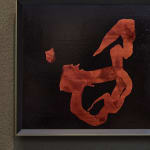Morita Shiryū (1912–1998)
Usobuku
Aluminum flake pigment and lacquer on paper, framed
c. 1963
With a label signed by Inada Sousai
38 x 42 cm
43 x 46 cm (overall)
c. 1963
With a label signed by Inada Sousai
38 x 42 cm
43 x 46 cm (overall)
Literature
Morita Shiryu Catalogue Raisonné: 1952–1998. Uji: Soryusha, 2019.
Shikkin, literally “lacquer and gold,” is a technique unique to Morita. Instead of using ink, he applied aluminum flake pigment mixed with glue medium on the paper, and then coated the work’s surface with lacquer. He experimented first with this technique in 1963 in order to improve stability of the paper ground, which tended to be easily damaged enroute to overseas exhibitions.
This version of Usobuku is among the rarest shikkin works by Morita as the Chinese character glitters in a copper red tone, unlike the golden hue that we are familiar with. Furthermore, compared to Morita’s other shikkin works, the brushwork here appears flat and weighty, and slight variations in tone seem to result from the uneven application of pigments. This suggests that the medium used here was of a more fluid consistency than usual. Morita presented his first shikkin works to the public at the Bokujin Group Exhibition of 1963, with most of them characterized by a golden hue for the characters, and vivid traces of brush movement. The present work represents Morita still at an early experimental stage between June and October of 1963, when after his from New York he worked on perfecting the ideal outcome of the shikkin approach.
Morita Shiryu (avant-garde calligrapher; 1912–1998)
Avant-garde calligrapher from Hyogo Prefecture. Like fellow artist Inoue Yuichi, Morita studied under the calligraphy master Ueda Sokyu. He co-founded the avant-garde group Bokujinkai together with Inoue and was the founder and editor of the journal Bokubi (Beauty of Ink), both of which revolutionized traditional Japanese calligraphy and spread knowledge of Japanese avant-garde calligraphy to an international audience. He was posthumously awarded the Medal of Honor with Dark Blue Ribbon.
This version of Usobuku is among the rarest shikkin works by Morita as the Chinese character glitters in a copper red tone, unlike the golden hue that we are familiar with. Furthermore, compared to Morita’s other shikkin works, the brushwork here appears flat and weighty, and slight variations in tone seem to result from the uneven application of pigments. This suggests that the medium used here was of a more fluid consistency than usual. Morita presented his first shikkin works to the public at the Bokujin Group Exhibition of 1963, with most of them characterized by a golden hue for the characters, and vivid traces of brush movement. The present work represents Morita still at an early experimental stage between June and October of 1963, when after his from New York he worked on perfecting the ideal outcome of the shikkin approach.
Morita Shiryu (avant-garde calligrapher; 1912–1998)
Avant-garde calligrapher from Hyogo Prefecture. Like fellow artist Inoue Yuichi, Morita studied under the calligraphy master Ueda Sokyu. He co-founded the avant-garde group Bokujinkai together with Inoue and was the founder and editor of the journal Bokubi (Beauty of Ink), both of which revolutionized traditional Japanese calligraphy and spread knowledge of Japanese avant-garde calligraphy to an international audience. He was posthumously awarded the Medal of Honor with Dark Blue Ribbon.



